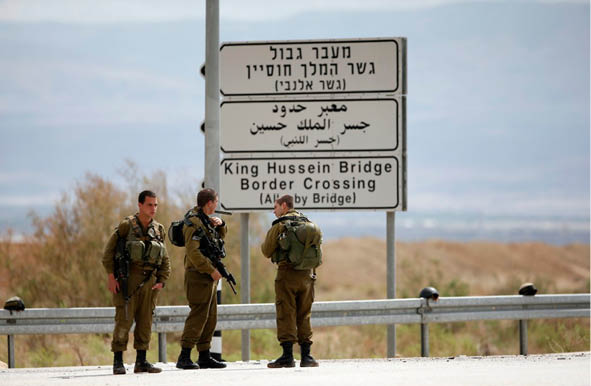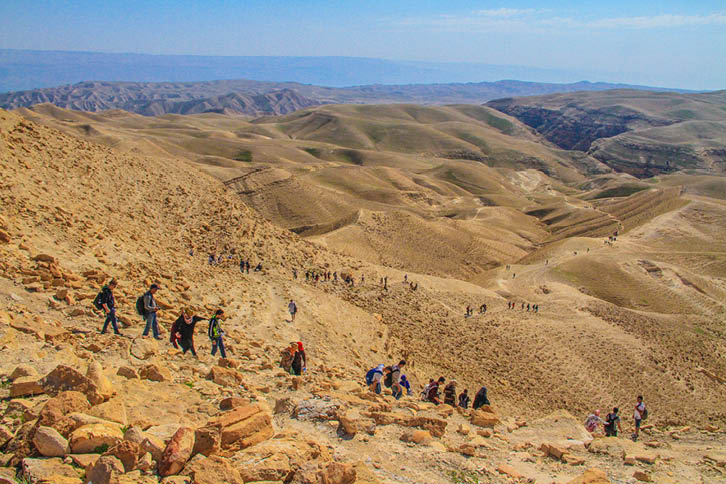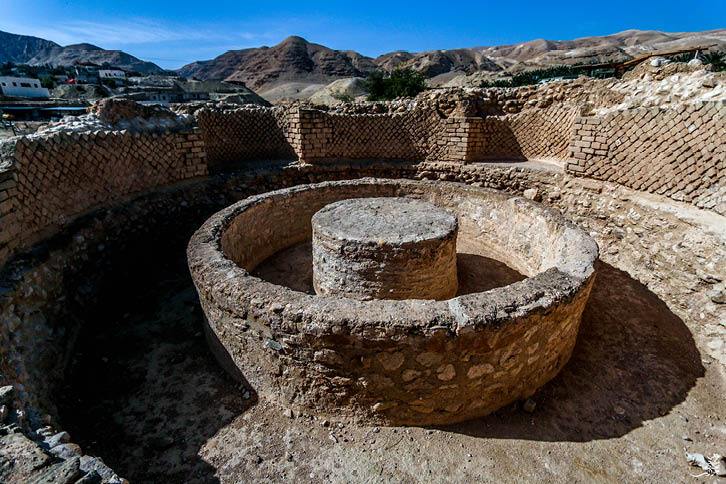Every Christmas we are faced with the same questions: “How many people are going to visit Bethlehem?” “How many people visited last year?” But while numbers are important, the situation of tourism in Palestine in general, and Bethlehem in particular, cannot be grasped by numbers alone. Palestine is one of the world’s oldest touristic destinations, yet its capacity to develop its own touristic industry is largely threatened by the Israeli occupation. Short-term goals such as increasing the number of visitors to the Church of the Nativity are achievable. The real question, however, is how to make Palestinian tourism a sustainable enterprise that honors its historical importance for Palestine’s economy and social fabric.
The World Tourism Organization (WTO) defines a tourist as someone who spends at least one night in a location. Otherwise, the person can be considered simply a visitor. Israeli official figures estimate that 4.5 million tourists entered Israel during 2019. These numbers are relevant because Israel controls all access points into occupied Palestine. Last Christmas, the official estimate of the number of tourists in Palestine in 2019 was 3.52 million – but this number includes what the WTO defines as same-day visitors. Nevertheless, having received three million visitors is still significant for a country under military occupation. Official figures mentioned a daily average of 240 touristic buses that reached the central bus station. But Bethlehem, the birthplace of Jesus, received significantly fewer visitors in 2019 than the museums of the Holy See (no less than six million visitors) or the sanctuary of Lourdes, France (approximately five million people).

According to data supplied by the Palestinian Ministry of Tourism, the approximate number of overnight stays booked in Palestinian hotels during 2019 was about 2.7 million. Thus, Palestine received around 900,000 tourists during 2019 (implying an average of three nights per tourist). A vast majority of these stayed in hotels in either Bethlehem or East Jerusalem. With the exception of the city of Ramallah and Jericho, there are few hotels that function elsewhere in the occupied West Bank. But even when it comes to same-day visits, areas of significant historical and religious presence in the northern West Bank, including cities and villages such as Nablus, Burqin, or Aboud, receive few or no foreign visitors. Sites with a slightly higher percentage of visitors, such as Sabastia, did not really enjoy the benefits of the numerous visitors that allegedly arrived in Palestine during 2019.
Tourists are not the same as visitors.
For years, certain stakeholders have attempted to deal with tourism while having to ignore the political and legal context imposed by the Israeli occupation. Yet ignoring the facts does not contribute to a sustainable Palestinian touristic industry. For some in the international community, tourism has represented an opportunity for cooperation with Israel as it has not been considered to be a “political file.” In practice this has not worked: Israel has the monopoly over all entry points to Palestine, including, most significantly the Al-Karamah (Allenby) Bridge and the airports (Gaza’s Yasser Arafat Airport has been destroyed, and the “Jerusalem Airport” in Qalandia has been turned into a new Israeli settlement). While the 1994 Paris Protocol stipulated freedom of movement for Palestinian tour operators, buses, and tour guides, Israel from the outset systematically violated its obligations in this regard. Before the closure imposed to curb COVID-19, 42 Palestinian tour guides held permits to enter Jerusalem, while over 7,000 licensed Israeli tour guides were allowed to work in the Holy City. After years of systematic Israeli violations of the interim agreements and Israel’s avoidance of assuming its responsibilities under international law, it is difficult to find a real framework of relations between Palestinian and Israeli tourism on the ground today. It is important to remember, though, that until a final status agreement has been signed, Israel remains the occupying power and its obligations are clearly established under international humanitarian law as well as with respect to several other international treaties.
Israeli monopoly over tourism has a direct effect on touristic itineraries that in most cases avoid plans to visit Palestinian cities other than East Jerusalem and Bethlehem. Even Jericho – the oldest still-inhabited city worldwide and Palestine’s bordering city with Jordan – tends to be visited for only a few hours by visitors who are then likely to be taken to Israeli-controlled beaches on the northern shores of the Dead Sea, to Qumran, and to the Baptism site (Al-Maghtas), all located in the occupied Palestinian territory, yet controlled by Israel, and in most cases, tourists have to pay entry fees for Israeli public and private institutions that are part of the illegal Israeli colonial-settlement enterprise.
Palestinians have made efforts to promote important places for Christian religious pilgrimage that tend to be left aside in Israeli-organized tours. Bethlehem 2000, created under the enthusiasm of the first days of the peace process to develop tourism, aimed to promote visits to locations along the path taken by the Holy Family during their travel from Nazareth to Jerusalem, which mainly included localities within today’s occupied West Bank. Why would a Christian pilgrim skip the church that marks the miracle of the ten lepers in Burqin? Or the Shrine of Saint Barbara in Aboud? Or Jacob’s Well in Nablus? Why would none of the thousands of Mexican pilgrims visit the Church of the Virgin of Guadalupe in Birzeit? The Samaritan community in Mount Gerizim is a treasure that very few tourists get to visit. The situation in the northern West Bank, a place with several Biblical locations where settlers try to bring visitors in order to push their political agenda, is an example of how, beyond creating economic revenues, tourism can serve as an effective tool to promote the exercise of Palestinian sovereignty. The list just goes on.
Tourism is being used by Israel as a tool to normalize the occupation.
In 2009, the Palestinian Ministry of Tourism published a list of sites that could potentially join UNESCO’s World Heritage List. Palestine became a full UNESCO member in 2011 and since then has inscribed three sites, including “Birthplace of Jesus: Church of the Nativity and Pilgrimage Route, Bethlehem” and “Palestine: Land of Olives and Vines: Cultural Landscape of Southern Jerusalem, Battir,” which includes Wadi al-Makhrour as well as the old town of Hebron/Al-Khalil.* Not all of these are frequented by Israeli-guided tours, and other important and beautiful sites are likely unknown among a majority of tour operators, let alone tourists. They include the Old City of Nablus and Mount Gerizim, Tell es-Sultan in Jericho, Wadi Natuf and the Shuqba Cave, the Umayyad Palaces (including Jericho’s Hisham Palace), and the “Throne Villages” that are located mainly in the northern West Bank, as well as “Al-Bariyah: Wilderness and Monasteries,” the area east of Bethlehem, which is on the tentative list of UNESCO cultural sites and includes Mar Saba Monastery and others. Sites in Gaza are being surveyed for potential inclusion on UNESCO’s World Heritage List, including Tell Um Amer, the Anthedon Harbor, and Wadi Gaza Coastal Wetlands. In a different situation, the Church of Saint Porphyrius, built in the fifth century, would be a mandatory destination for pilgrims.
It is no secret that Israel has promoted its own touristic industry using images that show the occupied Palestinian territory, including the Old City of Jerusalem, the Dead Sea, and even Bethlehem. Moreover, a number of foreign companies, such as Airbnb and Trip Advisor, openly promote places in Israeli settlements, including stays in most of the 18 settlements that surround Bethlehem. The Israeli parliament hosted a delegation of Brazilian MPs, including Eduardo Bolsonaro, the son of President Jair Bolsonaro, who visited the illegal colonial-settlement of Psagot on the outskirts of Ramallah and had dinner at its winery. This visit should not be understood merely in the context of an increasing number of right-wing populists who disregard international law and a world order based on rules. According to the Israeli Ministry of Tourism, Brazil brings the largest number of tourists to Israel from Latin America, around 62,000 in 2018 alone. With an increasing radicalization of Christian Zionist groups, tourism to settlements is a strategic goal for those who wish to promote their presence in occupied Palestine, leading groups of religious fundamentalists to settlements in the Bethlehem, Hebron, and Nablus areas.
Palestine’s lack of border control has stifled its regional potential by preventing the entry of tourists from many Arab and Islamic countries.
But this is not only about ideological support for Israel’s colonial-settlement enterprise. In 2000, Israel inaugurated a prominent complex of hotels along Road 1 in Jerusalem. Few would distinguish that these three hotels, with a total capacity of almost 1,200 rooms, are located in Occupied East Jerusalem. They have more rooms than the combined capacity of about 20 Palestinian hotels in the city. Before the 1967 occupation, Jerusalem was the center of tourism, much more developed than Bethlehem. Today, developing in East Jerusalem is extremely difficult for a Palestinian. Likewise, in Bethlehem: Israel’s advancement of its annexation plans serves as a reminder that the vast majority of Palestinian investments are limited to areas that are under the control of the Palestinian government – representing no more than 14 percent of Bethlehem Governorate. The World Heritage Site of Battir and the entire area west of Bethlehem, where archeological sites mix with a green landscape that includes Cremisan Valley and Monastery, are all in line for annexation.
Israel’s control over the border crossings into Palestine has prevented the entry of large numbers of tourists coming from Arab countries and countries that are part of the Organization of Islamic Cooperation. This closure is one of the aspects that has severely undermined Palestine’s touristic potential and prompted several religious leaders and groups to call for peaceful actions to hold Israel accountable for its obligations towards the Palestinian people under its occupation. In 2017, tourism contributed less than 3 percent to the Palestinian GDP. Tourism in Israel, including its illegal colonial-settlement enterprise and a more diverse economy, contributed with 6 percent of the GDP. Palestine’s numbers, though, are significantly lower than those of Jordan (19.4 percent in 2018) and Egypt (13 percent), and even lower than those of Lebanon (7 percent in 2018). The so-called “Deal of the Century” proposed by the United States allegedly addresses this issue, yet it only offers a perpetuation of the current reality, as Palestine will not have sovereign control over any of the areas required to properly develop its tourism sector. Notwithstanding that the plan totally ignores Arab Christians and continues to negate the basic attributes of a Palestinian tourism-oriented economy, including the prospects of having an airport.

To move forward, the unique characteristics of Palestine, from its geographical location and history to religious significance and cultural heritage, should certainly prompt stakeholders to envision a future that goes beyond the current model under which tourism is being analyzed. Current efforts, such as the construction of new hotels in Bethlehem, should be taken as a sign of Palestine’s potential – despite all the problems – rather than the end of the road.
Obviously, there are high barriers imposed by the Israeli occupation that have to be dealt with in the short term. Yet nobody who is truly concerned about the potential of tourism in Palestine could envision a strategy for the future that does not aim to eliminate such barriers. This should include parallel tracks that focus on tackling the obstacles imposed by the occupation, including by denouncing Israeli attempts to normalize its occupation/annexation through tourism and the companies involved. Efforts must furthermore promote Palestine by making use of what has already been gained (such as the UNESCO World Heritage sites), highlight Palestine’s comparative advantages (beyond just the city of Bethlehem), and develop the necessary infrastructure for domestic and foreign tourism (beyond hotels). This needs the combined efforts of the government, the private sector, and civil society, including the churches.
The model that defines how tourism is conducted in Palestine must be changed.
A main demand should be the development of tourism guidelines for Palestine by the relevant authorities, including the European Union, which represents the most significant number of visitors. Churches should also play a role in promoting ethical tourism guidelines for their pilgrims. Specific guidance should be given to tour operators with regard to promoting Israeli-settlement businesses and marketing sites that are located in the occupied Palestinian territory as part of Israel. Discouraging conducting business with Israeli settlements has long been a policy endorsed by the vast majority of the international community. Yet Israel’s systematic and ongoing policies with regard to its illegal colonial-settlements, particularly in the context of the current prospects of annexation, are a reminder of the international responsibility to act.
Israeli restrictions on the development of important archeological and touristic sites are known. From Sabastia to Herodion Mountain and the Jordan Valley, there are significant examples of how Israeli colonial-settlement policies undermine Palestinian efforts. The latest theft of a sixth-century baptismal font from Tekoa is a reminder of how Palestinian cultural heritage and archeological artifacts have been dealt with in the absence of effective Palestinian control. The international community has a responsibility to support Palestine in protecting such places.
Even when it comes to Bethlehem, visitors don’t get to experience the richness of the governorate, home to several places that are not part of the regular touristic packages, including Saint Nicholas Church of Beit Jala, Solomon’s Pools and the Monastery of Artas, Saint George Monastery of Al-Khader, and the World Heritage site of Battir. The Syriac community, with a church that still prays in Aramaic, is largely ignored though it is only a few steps away from the Church of the Nativity. The promotion of new sites of religious significance, such as Taybeh (the biblical “Ephraim” where the infrastructure to receive tourists exists, with hotels, restaurants, and the famous brewery and winery), Aboud (which, in contrast to Taybeh, lacks basic infrastructure), Nablus, and Burqin, should be a priority. Such places can also benefit from domestic tourism. The end of the siege over Gaza and its reunion with the rest of Palestine has the potential to open new important archeological and touristic sites that today are off-limits even for the majority of the Palestinian people, let alone foreigners.

Some successful tourism projects are run by civil society and prove that it is possible to bypass some of the barriers imposed by the Israeli occupation. For example, Rozana Association for Rural Tourism helped rehabilitate the old town center of Birzeit. An annual festival is now attended by thousands, and small shops and restaurants are very popular among domestic visitors. Hosh Al-Syrian Guest House, an old network of small houses rehabilitated by Italian municipalities as a cooperation project for the benefit of Bethlehem Municipality, has become a landmark for the expatriate community of diplomats in Palestine, particularly with its well-known restaurant Fauda, which promotes Palestinian food and products in some of the most influential international media outlets. Masar Ibrahim is one of the most successful cases of promoting Palestine worldwide: The various trails that cover the entire West Bank, including East Jerusalem, should no longer be referred to as “alternative tourism”; this kind of tourism should be promoted as typical for Palestine. Even simple initiatives in social media, such as “Ahlan Palestine” or the Siraj Center have been able to promote foreign and national tourism through beautiful images of sites and places that in many cases are rarely visited.
Tour operators must honor Palestine’s history, and Bethlehem should not be treated as a cheap subcontractor of Israeli tour operators.
The various churches also have an important role to play in inviting groups to visit the realities of their Palestinian sister communities. This may require the construction of some basic infrastructure in important places that today lack hotels or restaurants. As long as religious pilgrimage remains focused almost entirely on Bethlehem and Jerusalem, the potential of other locations will be neither explored nor unveiled. While it is true that most Israeli tour operators determine their itineraries, Palestinians and their friends have the moral responsibility to promote what tourists and pilgrims can or should see and experience in Palestine, including not only the sites but also the people.
Investing in Palestine’s tourism sector means investing heavily into Palestine’s touristic heart, namely Jerusalem–Bethlehem, and building on its comparative advantages, including Palestine’s cultural heritage and identities. But it also includes developing the dozens of other sites that are spread throughout the country. Palestine’s membership in international organizations, such as UNESCO, should serve to consolidate this approach, yet this requires a comprehensive and holistic effort by various actors. Tourism constitutes a unique medium to present Palestine to the world, including the deep roots of the Palestinian people in this land. “Jesus was born in Bethlehem; Bethlehem is in Palestine” is a simple equation that is still difficult for some to realize. Reclaiming its sites is a way for Palestine to exercise sovereignty over its homeland. This should be a strategic target for tourism-related institution building and capacity expansion in Palestine. It should not be forgotten that Palestine is much more than Bethlehem, and that history and cultural heritage are key components of Palestine’s national narrative in its struggle for freedom.
Promoting Palestine should go hand-in-hand with challenging the barriers imposed by the Israeli occupation. Such efforts must include networking with all the actors that are truly interested in contributing to an independent Palestine – with a vibrant touristic industry as a driver of the country’s economy. The Palestinian government’s plan to turn Bethlehem into a touristic cluster should be considered an opportunity to realize this vision.
* The “Old City of Jerusalem and its Walls” was registered by Jordan in 1981.


